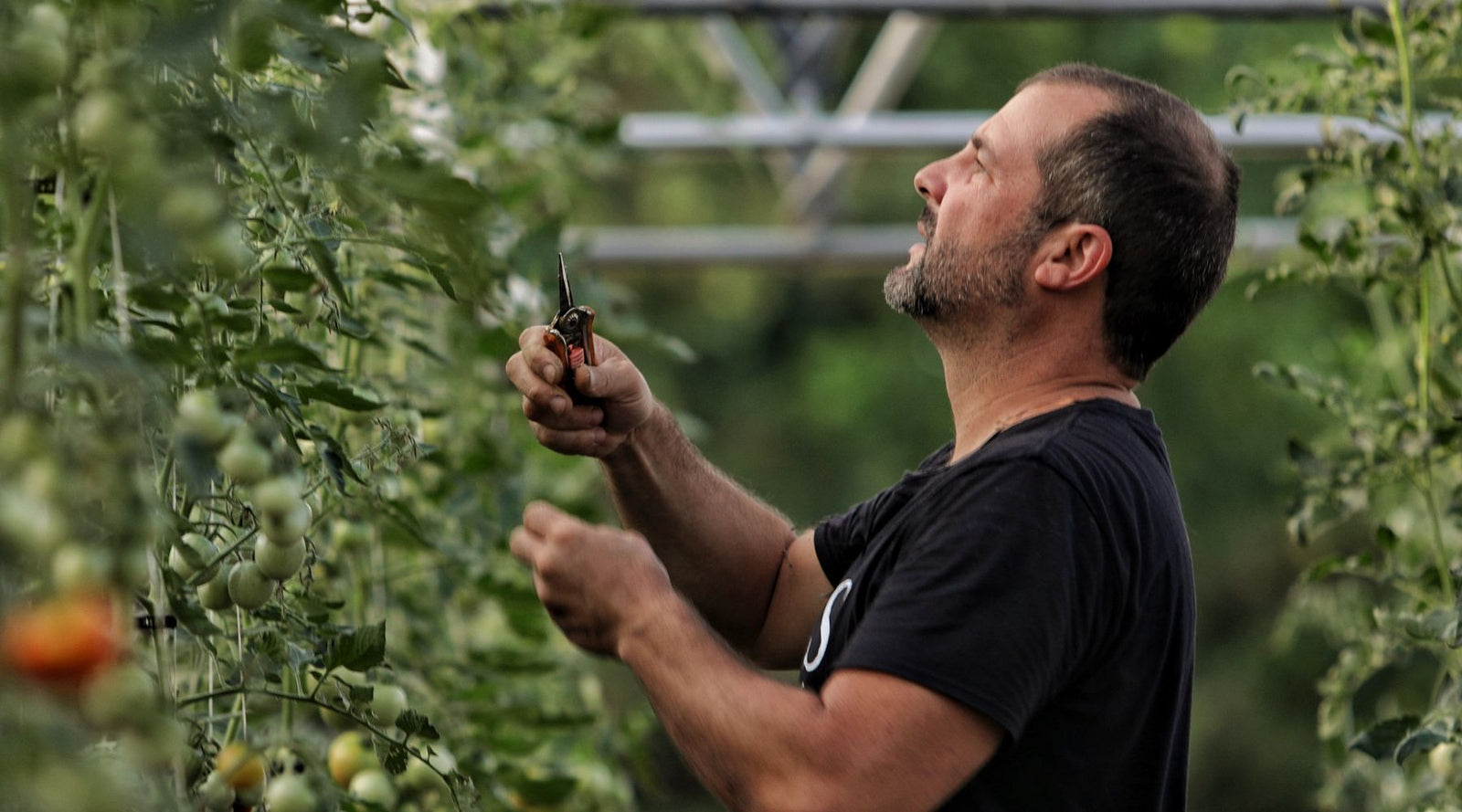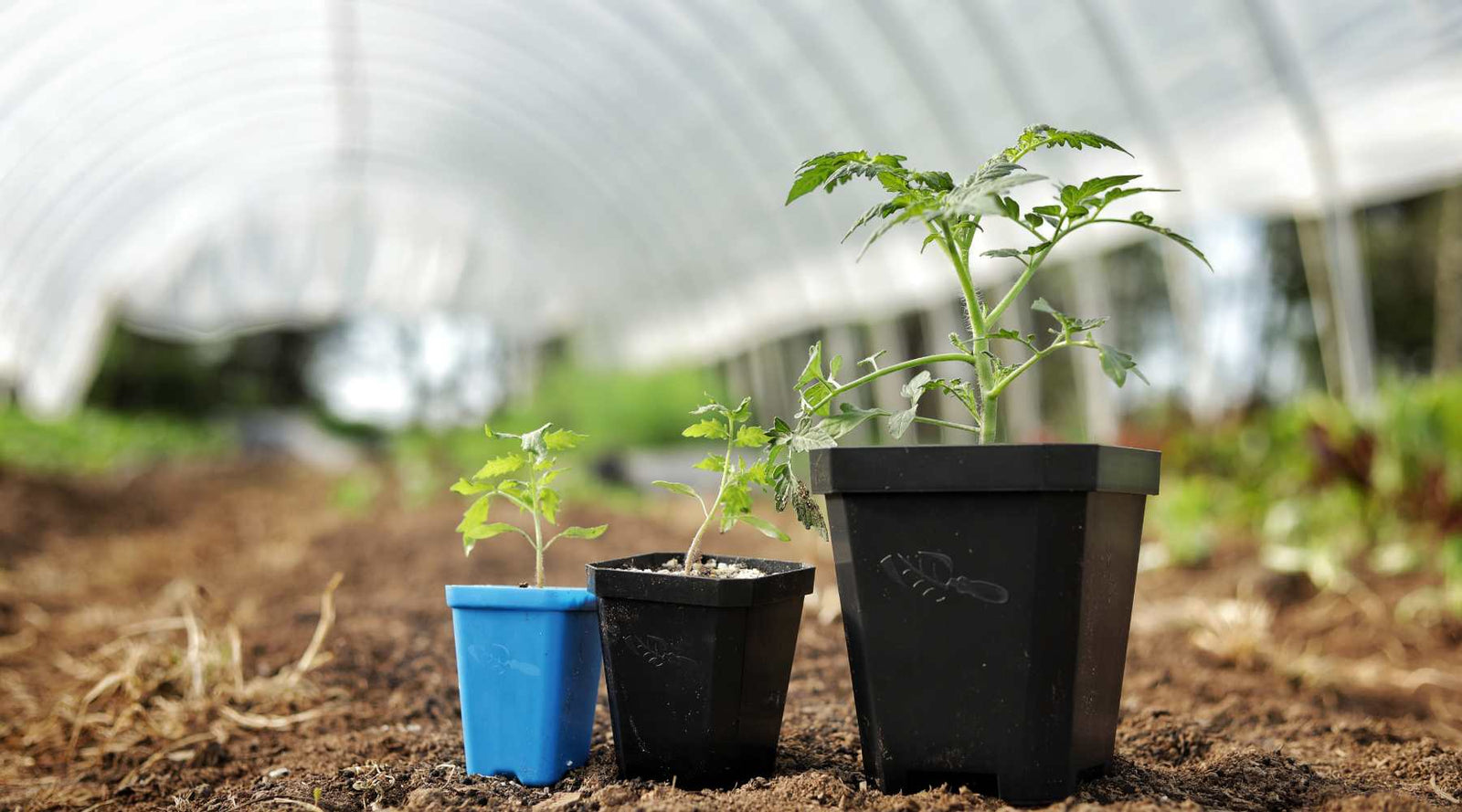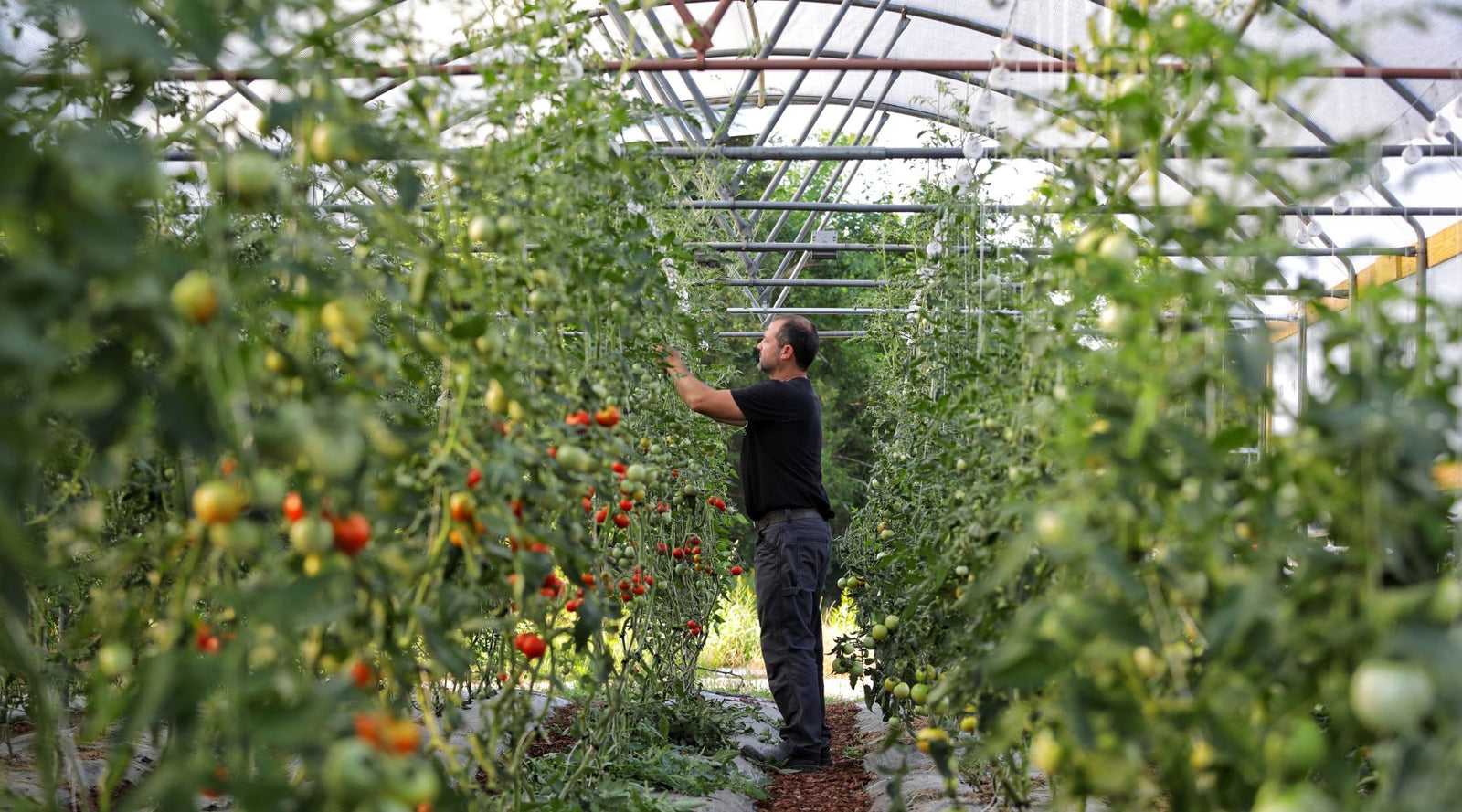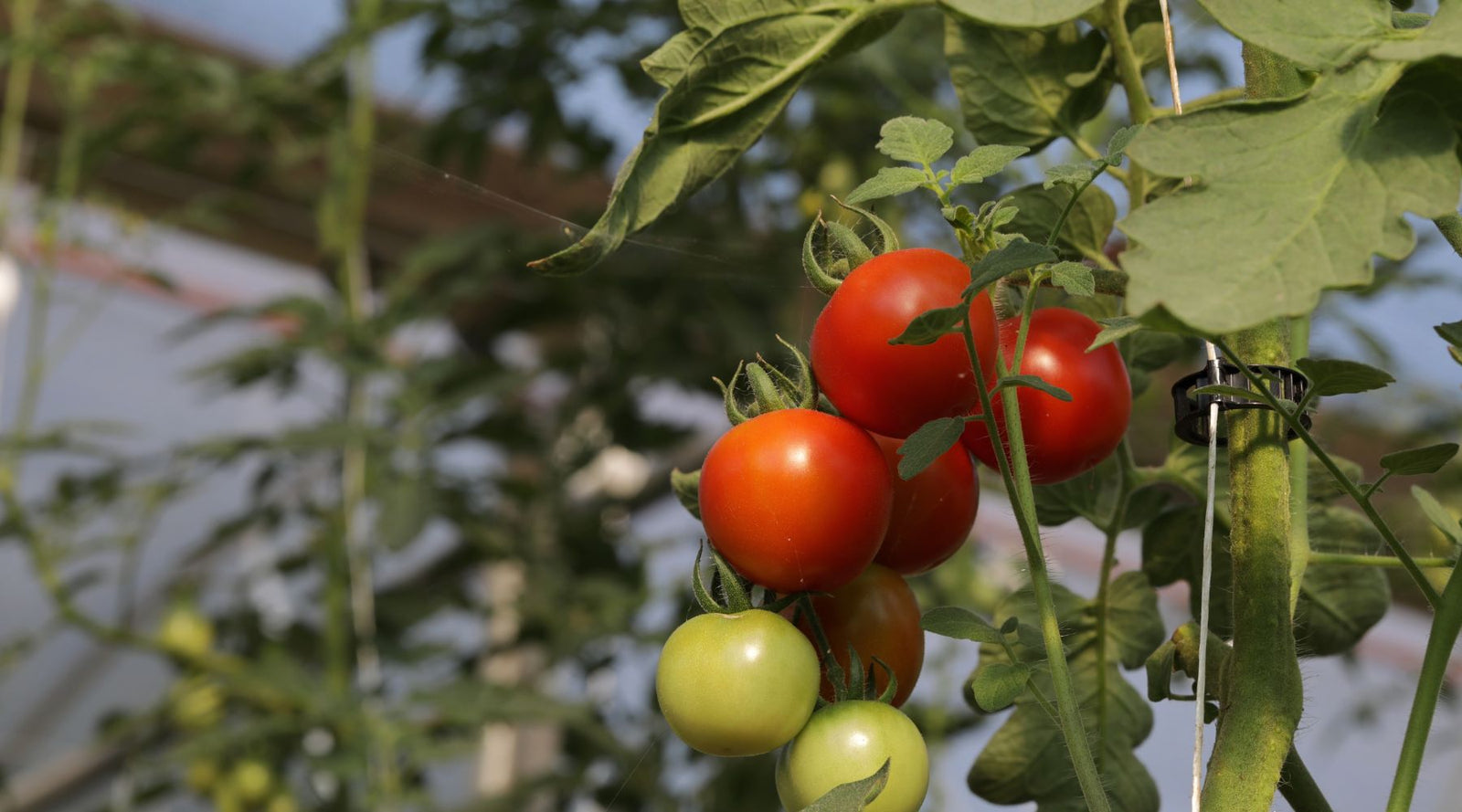Free Shipping on Orders over $75 to the Contiguous US
Free Shipping on Orders over $75 to the Contiguous US
Pruning Indeterminate Tomatoes for Maximum Production in a Hoop House
April 03, 2024 5 min read 0 Comments

Here, we will walk you through how to prune and trellis to get the most from your plants. Each of the articles in this series has an accompanying video to let you see the process in action. With Nick from Bootstrap Farmer, we start this four-part series by walking you through how to identify and prune the parts of indeterminate tomato plants.
Before Nick came on at Bootstrap, he had a successful market garden where he grew tomatoes year-round in a 30 by 36 heated greenhouse using a Dutch bucket system. He also grew seasonal tomatoes in an unheated 30 by 100-foot hoop house, both bush varieties and indeterminate, as well as specialty tomatoes in outdoor raised beds. In these articles, we distill down his years of experience to help you increase your production and maximize your growing space.
Why Aggressively Prune Indeterminate Tomatoes?
Why does Nick cut off so much? To those not used to pruning, the amount of foliage that he removes may seem aggressive. Keep in mind that tomatoes are resilient plants. When you remove excess leaves, spent clusters, and redundant suckers, you are teaching the plant.
Pruning tells the vine where you want the energy focused. The techniques we describe here can also be used on outdoor plants. Trellised plants in direct sun will want a little more foliage left on to help protect the fruit from sun-scald.
Start by learning to identify the parts of a tomato plant
Crown - The top section of the plant. This is the area where you will select one strong sucker to continue the vertical growth of the plant. Flowering will start in this section.

Main Stem - This is the central stalk of the plant. Often referred to as the leader. A single leader plant is developed when the grower chooses one sucker to continue growing and removes all others.

Shoulder or Axil - Any junction of leaf and stem.
Sucker - An immature branch that grows out between the main stem and a shoulder.

Leaf - Tomatoes have compound leaves made up of leaflets which are distributed along the leaf rachis (central leaf stem).

Flower Cluster - Also known as an inflorescence, these are composed of a central branch with multiple smaller branches terminating in individual flowers. The number and arrangement of flowers in a cluster is dependent on many factors including variety and growing conditions.

Fruiting Cluster - A flower cluster that has been fertilized and is developing into ripe fruits.

Identify the growing sections of a tomato plant
From top to bottom, each section of the trellised tomato plant has its job. Each of the four distinct zones will look dramatically different. This is because each section of the plant has a different job to do.

Crowning and Flowering
In the top section, you will be teaching each of your plants to focus on a main stem and allow a single sucker to continue vertical growth. Below this crown point, additional suckers will be removed to discourage branching
Fruit Set and Vegetative Growth
Directly below the crown. This is where the majority of photosynthesis will take place. Additionally, flower clusters will begin to set fruit and should be pruned to 4-7 fruits per cluster, depending on the type. Cherry tomato varieties can hold up to 7, larger fruits should be thinned to prevent too much weight on the fruiting branch.
Fruit Harvest Zone
Harvesting happens below the vegetative section. In this area, you will remove most leaves to allow for better airflow and focus the nutrients on fruit ripening. This also helps streamline the harvesting process since you are not having to work around leaves to find fruit.
Bare Stem Racetrack
This is where you have removed all the fruiting branches post-harvest. This section will be lowered to run parallel to the floor and wrap around the base of the plants or pots. These vines can end up 50-70 feet long, so we will go over lowering and leaning the vines in the next article.
Tools you will need to begin trellising and pruning your tomato plants
- Support Structure
- Hooks to hold the trellis line to the support structure
- Trellis Line
- Stem Clips or Ties
- Clippers, make sure they are sharp and clean.
How to Prune Your Indeterminate Tomato Plants
Keeping the bottoms of the plants free of foliage and old branches is vital for proper airflow. Higher on the plants you will leave fruiting branches and some foliage. At the crown of the plants leave more foliage to shade developing fruits. This also provides plenty of photosynthetic energy to keep the plant growing. On trellised plants it is ideal to prune a day or two after each harvest. Treat each section of the plant according to its particular job. Add clips as needed to support the vine.
Bare Stem Racetrack
Remove all leaves and any branches left from harvested fruits. Here you are creating more bare stem to lower and lean in the next step. Bare the stem up to the next harvestable cluster.
Fruit Harvest Zone
Remove all remaining leaf clusters except possibly those directly opposite a fruit cluster. This focuses the plant’s energy on ripening fruit. The increased airflow will also help mitigate pest pressure. If some clusters have fruit at dramatically different stages of ripening you can prune the smaller fruits off. 4-7 good fruit per branch depending on size. Remove any misshapen or damaged fruit.
Fruit Set and Vegetative Growth
Remove all suckers from the main vine stem including any emanating from a fruit cluster. Remove extra flowers from any cluster that has more than the desired 4-7 fruits setting. Remove any leaves with browning or pest damage. Remove any small branches that are forming from shoulder points off the main stem.
Crowning and Flowering
Carefully attach the crown of the vine to your trellis line with a clip placed just below the lead sucker. If you are rehabbing a vine you may leave an extra sucker to choose the best after another week of growth. Remove any suckers from leaf axils below this point. Keep all foliage in this section.
What comes next for your tomatoes?
Now that you know how to identify the parts and prune an individual plant, you can proceed to the next steps for trellising tomatoes. Once a plant is pruned, you can move on to lowering and leaning. If you are getting ready to build a trellis and need help with supplies and design, feel free to skip ahead to part three, where we discuss trellising structures in the hoop house. Be sure and go back to lowering and leaning before your first prune so you have a plan in mind.
Already have your structures built but haven't pruned yet? Maybe the pruning got away from you for a few weeks? It happens on the farm, sometimes other tasks get in the way. Even if you feel overwhelmed by those wild plants, don't despair. In the 4th part of this series, we will go in-depth into the challenges and opportunities when pruning overgrown plants in a hoop house.
Watch the Tomato Pruning Video!
Also in Growing Tomatoes

Growing Tomatoes for the Urban Farm
March 17, 2025 6 min read 0 Comments

Managing Overgrown Tomatoes
April 03, 2024 10 min read 0 Comments

Using the Lower and Lean Method for Indeterminate Tomatoes in a Hoop House
March 12, 2024 5 min read 0 Comments
The lower and lean method of trellising indeterminate tomatoes in a hoop house has many advantages. Ease of working conditions and maximum fruit production are the key features of this style of tomato growing. When done properly pruning along with lowering and leaning will increase productivity and keep your plants healthier.
Recent Articles
- Growing Tomatoes for the Urban Farm
- Managing Overgrown Tomatoes
- Pruning Indeterminate Tomatoes for Maximum Production in a Hoop House
- Using the Lower and Lean Method for Indeterminate Tomatoes in a Hoop House
- Building Trellis for Indeterminate Tomatoes
- The Ultimate Indoor Tomato Seed Starting Guide for Gardeners
Subscribe
Sign up to get the latest on sales, new releases and more …
